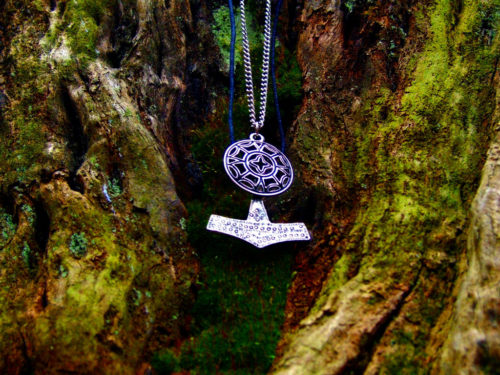UNITED STATES — When two men were fatally stabbed and another injured on a Portland train in May, officials and journalists began to follow the predictable course of profiling the attacker in an effort to understand why he would resort to such actions. After a few short days, several sources began to speculate on his Heathen religious practice, more specifically on Odinism.
This assumption rests squarely on Facebook posts made the attacker over the past year. On May 9, he wrote, “Hail Vinland!! Hail Victory!!”

[Photo credit: Paul Walker.]
The term Vinland has more recently become a rallying point for white supremacist groups and has been used in the naming of related organizations, such as the Wolves of Vinland. In a post last fall, the Oregon attacker wrote, “I Hereby Solemnly swear to Die trying to Kill Hillary (Herself a filthy Murderess) Clinton and Donald Trump should they be elected to the post of President in my faire country on Vinland” [sic].
The ideological meaning placed on Vinland in these cases is not entirely dissimilar from the Trump administration’s call to “make America great again.” At their core, both rallying cries center around a false nostalgia, hearkening back to a time when life was allegedly better than it is today, and promising that a return to that illustrious time would fix all modern problems. Although similar, one cry is far more openly extreme than the other.
Along with using Vinland, the Portland attacker has also referenced other Pagan or Heathen terminology, and has suggested that he harbors polytheist beliefs. According to one news report, he was introduced to such religious practices while in prison for another crime.
Most recently, in an Apr. 19 post, the stabber wrote, “May all the Gods Bless Timothy McVeigh” and then quoted William Ernest Henley’s poem Invictus. In an earlier post he says he’d like to put an end to the “monotheist question,” threatening to kill “All Zionist Jews, All Christians who do not follow Christ’s teaching of Love, Charity, and Forgiveness.”
As the mainstream media continued to follow the line of reasoning that the attacker was indeed an Odinist, various Heathen organizations issued statements in response to these claims.
The Troth condemned the attack, reflecting on the need for in-prison military services. Mallory Brooks, program coordinator for the organization’s In-Reach Heathen Prison Services, wrote: “Our hearts go out to the targets and victims of last Friday’s attack. The alleged perpetrator brought shame to our religion and, in the eyes of many, to our gods and goddesses. This is unacceptable.”
Heathens United Against Racism’s statement offered its support to the family, adding that the “Portland Killer is our community’s responsibility, and we must do everything we can to prevent it from happening again.”
“The Portland Killer’s actions didn’t happen in a vacuum,” reads HUAR’s statement. “In an environment where hate-speech is being normalized and promoted, it tends to bubble over into violence.”
Both the statements from the Troth and HUAR work from the assumption that the man was indeed Heathen in some way, and send out a call to action to the greater Heathen community to join in the fight to stop the use of Norse mythology and related modern religions to justify extremist violence. Their pleas are not unlike those often found in the Muslim community.
However, not all Heathens were convinced that this man was actually co-religionist. Wild Hunt writer and author of The Norse Mythology Blog Karl E. H. Seigfried told a reporter that the stabber’s various Facebook rants “invoke Lilith (Jewish), Tiamat (Babylonian), and Lucifer. His oath ‘to Odin, Kali, Bastet and all other Pagan Gods and Goddesses in my Aryan Theosophical Nucleus’ concludes by invoking Jesus Christ and Bernie Sanders.”
He goes on to argue: “This muddles together Norse, Hindu, Egyptian, Christian, and Jewish figures with ‘an unsectarian body of seekers’ whose founder was baptized in the Russian Orthodox Church.”
“To pick one thread out of this insane tapestry and declare it to be the religious determiner of […] hate would be nonsensical.”

Seigfried makes a point. Over the past year, the stabber posted information about ancient Egyptian gods and goddesses; he called specifically to Gaia, Kali Ma, and even Jesus. On Apr. 28 he wrote, “Until you cross that line then nothing will stop our come to Jesus talk friend or foe. If our come to Jesus talk fails you will face the come to Lucifer talk.”
The only term that stands out as repetitive is Vinland, which has become interwoven in contemporary white supremacist ideology, independent of religious practice. As Seigfried suggests, this points directly to the question of whether or not this man actually practices any form of religious Heathenry.
Are the stabber’s words simply the markings of a supremacist viewpoint? If so, another question arises. Should the use of Norse mythology simply as symbolism or as a coating for extremist ideology, rather than as true religion, be enough to push Heathens into action? Is the attacker their responsibility, as suggested by HUAR and the Troth?
This is where the proverbial waters are muddied, and the Heathen community’s struggle becomes increasingly difficult. Publicly speaking, connections are being made between the religious practice, the mythology, and extremists acts. Picking them apart is not always easy.
In 2015, the Richmond Dispatcher asked the question: are white supremacists in prison using a Pagan religion to radicalize young men? The article was written after the FBI broke up a ring of men who were plotting to attack a number of synagogues and black churches in Virginia. The article posits that there has been a growing number of Odinists and Asatruar in the prison system, but it also notes that there is a growing number of white supremacists.
The analysis provides no speculation on where the intersections between religious beliefs and extremist views lie, and how the reported statistics correlate. Which ideology is bred first? Do white supremacists find Odinism? Or do Odinists find white supremacy? It is a chicken-and-egg question.
In the recent Troth statement, Brooks explains: “Racist groups within prisons often engage in bullying tactics to instill fear into inmates who do not hold such views, and the racists’ rhetoric and dominance cause them to be the Heathens most visible to the correctional officers, chaplains, and administrators, who often do not understand the dynamics at play.
“As such, the racists become who defines Heathenry in many of these facilities.”
Brooks believes that a better, stronger, and more extensive Heathen prison ministry can help clarify the divide and support inmates, who are genuinely interested in the religion, from getting caught up in the game being played by supremacists.
As suggested by the above article, Heathenry, in these radicalized forms, is reportedly attracting a large number of young men, which is similar to reports on Islamic extremism.
Dr. Jennifer Snook, lecturer of sociology at Grinnell college, speculates: “White supremacists are attracted to it […] sometimes, but often just because they’ve seen the show Vikings, and it allows them to enact a hypermasculine performance while appealing to their (imagined) super-white Northern European bloodlines – a source of perceived privilege and status when other avenues of power (economic, political, manhood) begin to feel cut off. ”
It is a way for these young men to find personal empowerment within a contemporary and changing landscape. Snook explains that this says more about the supremacists than the religion, and she adds that the connection is nothing new.
“There is historical precedent for white supremacists (think: Third Reich) to co-opt images of Germanic warriors, gods and heroes in an appeal to the epic past (think: Wagner). Norse mythology is the cultural inheritance of Northern Europe – the whitest of white folks. It’s also perceived as “untarnished” by Christians – which is completely untrue (the stories were recorded by monks, after all) – which white supremacists view as a ‘desert religion’ for the racial ‘other.’ Add to that an overdose of hypermasculinity, and you’ve got quite a mess.”
As Snook suggests, the connection between the extremist ideology and symbolic presence of Norse mythology is obvious when placed in an historical context. However, what about the modern practice of Norse-based religions? In the suggested framework, these religions have become victims, being pulled unwittingly into a universe of hate.
“The increase in white supremacy isn’t a Heathen problem, it’s an American problem, ” Snook says. “It indicates more about the current political climate in the United States than anything that Heathens are doing or saying.”
Snook’s comment returns to the question of responsibility; a question that can be posed to any religious subgroup. Are violent extremists, who openly claim or use a religion to justify violence, the responsibility of the rest of that religious community, even if the extremist is not practicing?
As suggested by the recent public statements, the members of both HUAR and the Troth believe that it is their responsibility. Both public opinion and the consistent media focus on the connection between Heathenry and extremism has significantly affected the work and lives of many Heathens worldwide. It keeps Heathen writers such as Seigfried and Snook busy with interview requests from mainstream journalists. This conflation was the catalyst for the formation of groups, such as the Alliance for Inclusive Heathenry, Heathens against Hate, and HUAR.
One interviewee who wished to remain anonymous keeps his religious practice hidden from coworkers and superiors, not because he’s worried about being labeled a devil worshiper, but because he is concerned, due to the public opinion, that he’ll be called white supremacist.
The reality of the situation has placed the Heathen community in the uncomfortable position of perpetual defense, waging a monthly, weekly and sometimes even daily public relations battle to protect and defend their religion against a minority of people who are using Norse mythology to define their ideology, whether or not they practice the religion.
This social problem shows no signs of ending; the Oregon attack is just another example in a long line of similar cases. Heathen organizations continue to remain vigilant with regard to the public relations issues, as well as suggesting proactive strategies to curb the problem.
HUAR is encouraging all Heathen groups and individuals “to create and enforce anti-discrimination/anti-harassment statements.”
With regard to her prison work, Brooks has said, “We ultimately want to be able to bridge a gap to help both the Chaplains and inmates understand that they don’t have to give into the hate. There are other ways and they don’t have to follow the crowd. This is truly the hardest part of prison outreach.”
“We will not give up and we will not give in.”
The Wild Hunt is not responsible for links to external content.
To join a conversation on this post:
Visit our The Wild Hunt subreddit! Point your favorite browser to https://www.reddit.com/r/The_Wild_Hunt_News/, then click “JOIN”. Make sure to click the bell, too, to be notified of new articles posted to our subreddit.